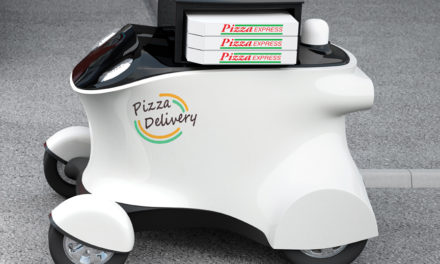Delivering innovation: Technology advances the restaurant industry
Technology is rapidly changing the way restaurants operate on site, online, in corporate HQs and throughout the supply chain. Restaurants of every size and style are adopting apps, software, robotics and artificial intelligence to take on the tasks that take up time, freeing teams to focus on their core purpose: delivering a great customer experience.
The National Restaurant Association’s month-long tech series covers the practical applications of technology in restaurants. Hospitality will always be the foundation of our industry. The right technology integrations can help us enhance the customer experience, improve operational efficiencies, and manage risks.
Customer facing tech
Delivering innovation: Technology advances the restaurant industry
Throughout October, the National Restaurant Association’s month-long tech series delves into some of the practical applications of technology in restaurants, from the basics and potential of AI to tech in the supply chain, customers’ tech preferences and tech-enabled location-based marketing that personalizes operators’ engagement with customers.
AI on the menu: A restaurateur’s intro to AI
Since AI is the development of computer systems that can perform tasks such as visual perception, speech recognition, decision-making, and problem-solving, it has many useful applications within the restaurant industry. It can improve operational efficiency and enhance customer experiences. By using AI, restaurant owners can remain competitive and responsive to shifts in customer needs in an ever-changing environment.
How to manage the POS “tip ask” so it’s not awkward for customers
Tipping has traditionally been one way waitstaff augments earnings without costing the restaurant more in wages, and many employees rely on tip income. Technology, however, has had an impact both on how employees are tipped and customers’ attitudes toward tipping.
AI on the menu: Using AI in service scenarios
Traditionally, dining room tasks—greeting (and seating) guests, taking and serving orders—are performed by people partly because it’s where customer interactions can make or break a dining experience but also because there haven’t been viable alternatives. Artificial Intelligence (AI) is changing that, handling tasks in ways that free employees to deliver even better customer service.
How important is reputation management?
Whether you use traditional or tech-enhanced methods, managing reviews is essential to business success. For restaurants, reputation can make or break a business. Because of the increase in social media platforms and rating sites, your business can easily receive praise or become someone’s venomous online target. Industry marketing expert David “Rev” Ciancio says managing your restaurant’s reputation is as important as delivering a great dining experience.
Tech to support operations
AI on the menu: Using AI for restaurant operations
To streamline back-office and kitchen operations, many restaurants are turning to artificial intelligence (AI) technologies. Its applications in the restaurant industry are far ranging and can greatly enhance the efficiency and productivity of operations. By automating repetitive or time-consuming tasks, analyzing data to predict future business, identifying upcoming tasks, and providing real-time business insights, AI can free restaurant staff to focus on more strategic and impactful activities, the ones that are customer-facing.
How AI technology can help you recruit, hire and retain employees
AI helped a 150-unit restaurant company save $840K in recruitment ads and shorten the hiring process from 10 days to 36 hours. As a leading advocate for growth and development of restaurants across the nation, the National Restaurant Association is committed to exploring cutting-edge solutions that can address the challenges faced by operators. One such solution that’s gaining traction is the integration of artificial intelligence (AI) to revolutionize employee recruitment, hiring, and retention processes. Embracing AI for hiring needs can be an effective way to enhance your back office experience, productivity, and bottom line.
Tech can help, but human-based hospitality still has a role
As the foodservice industry adopts and adapts to advances and innovations in technology, consumers still want their dining experiences to include employee-based service, new National Restaurant Association research finds. While many consumers, especially Gen Zs and millennials, embrace the new technologies they’re finding in restaurants (think digital ordering, automation, self-order kiosks, and cashless/contactless payments), there are still some customers, such as Gen Xers and Baby Boomers, who aren’t yet used to using it. They’re willing to try it though they may not feel entirely comfortable to start. And while that tech-shy sentiment may decrease with time, all diners tend to prefer the full employee service that enhances their dining experiences.
Macro tech trends
AI on the menu: Getting started
What are your business bottlenecks? What part of your business would you like to improve? What’s keeping you and your employees from delivering the best customer experience? Whether it’s optimizing your supply chain and lowering food costs, improving service speed and accuracy, or promoting your concept over the competition, chances are there’s an AI solution available.
AI on the menu: How AI is transforming the restaurant corporate office
From financial analysis to supply chain optimization, there are lots of business operations that can be addressed through the application of AI at a restaurant group’s corporate office level. By harnessing the power of AI, restaurant groups can gain a significant competitive advantage and drive growth. Artificial Intelligence (AI) has emerged as a powerful tool that can streamline operations, inform decision-making, and boost productivity across the enterprise.
New supply chain tech aids in effectiveness and efficiency
Real-time data empowers decision making to enhance efficiency, reduce costs and waste. Several new, innovative technologies are giving operators quick access to more data that can help them make better purchasing decisions, take advantage of optimal pricing, and ensure quality.
Marketing your business with tech
Streamlining restaurant technology with SpotOn’s Kevin Bryla
Sponsored by SpotOn, National Restaurant Association’s Chief Information Officer Kevin Steele talks restaurant technology with Kevin Bryla, the Chief Marketing Officer of SpotOn, and Emma Blecker, chief of staff & director of business systems at Boqueria. They discuss tech bloat — the over-adoption of technology and software solutions — its cost implications, the importance of streamlining tech stacks, and the positive role tech can play in the employee experience.
Reach restaurant customers where they are; offer what they’re looking for
Whether it’s a Facebook ad or a paper flyer pinned to a bulletin board, location-based marketing (LBM) is all about targeting consumers based on where they are. “It’s the intersection of people, places and media,” says Asif Khan, founder and chairman of the Location Based Marketing Association. “It’s about: Who are you trying to reach? Where are they? And what medium is available to you to reach them in that place?”




























